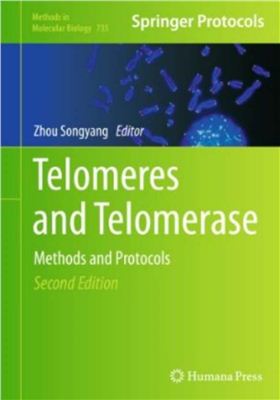Humana Press. 2011. 203 p.
New and rapid advances in technology have equipped us with a variety of tools and platforms to ask fundamental questions of telomere regulation and have allowed investigators to carry out experiments using diverse model systems. For example, proteomic, genomic, and molecular approaches have afforded us unprecedented insight into the complex protein interaction networks at work on the telomere chromatin and the detailed information regarding telomere dynamics in response to stress or stimuli. Telomeres and Telomerase: Methods and Protocols, Second Edition builds upon the telomerase assays featured in the popular first edition to encompass many different assays that allow investigators to query the function of telomere proteins and the responses of the telomere DNA, including detailed examinations of biochemical, molecular, and proteomic approaches. Written in the highly successful Methods in Molecular Biology™ series format, chapters include introductions to their respective topics, lists of the necessary materials and reagents, step-by-step, readily reproducible laboratory protocols, and expert tips on troubleshooting and avoiding known pitfalls.
Authoritative and practical, Telomeres and Telomerase: Methods and Protocols, Second Edition serves as an ideal, up-to-date guide for investigators further pursing this vital field of study.
Contents
Introduction to Telomeres and Telomerase
Analysis of Average Telomere Length in Cultured Human Cells
Telomere Length Analysis by Quantitative Fluorescent In situ Hybridization (Q-FISH)
Telomere Strand-Specific Length Analysis by Fluorescent In Situ Hybridization (Q-CO-FISH)
Telomere G-Overhang Length Measurement Method 1: The DSN Method
Telomere G-Overhang Length Measurement Method 2: G-Tail Telomere HPA
Telomere Terminal G/C Strand Synthesis: Measuring Telomerase Action and C-Rich Fill-In
G-Quadruplex Structures and G-Quadruplex-Interactive Compounds
Analysis of Yeast Telomerase by Primer Extension Assays
Telomeric Repeat Amplification Protocol: Measuring the Activity of the Telomerase
CO-FISH, COD-FISH, ReD-FISH, SKY-FISH
Visualization of Human Telomerase Localization by Fluorescence Microscopy Techniques
Cytogenetic Analysis of Telomere Dysfunction
Probing the Telomere Damage Response
Analysis of Telomere Proteins by Chromatin Immunoprecipitation (ChIP)
Studying of Telomeric Protein–Protein Interactions by Bi-Molecular Fluorescence Complementation (BiFC) and Peptide Array-Based Assays
Human Telomere POT1-TPP1 Complex and Its Role in Telomerase Activity Regulation
New and rapid advances in technology have equipped us with a variety of tools and platforms to ask fundamental questions of telomere regulation and have allowed investigators to carry out experiments using diverse model systems. For example, proteomic, genomic, and molecular approaches have afforded us unprecedented insight into the complex protein interaction networks at work on the telomere chromatin and the detailed information regarding telomere dynamics in response to stress or stimuli. Telomeres and Telomerase: Methods and Protocols, Second Edition builds upon the telomerase assays featured in the popular first edition to encompass many different assays that allow investigators to query the function of telomere proteins and the responses of the telomere DNA, including detailed examinations of biochemical, molecular, and proteomic approaches. Written in the highly successful Methods in Molecular Biology™ series format, chapters include introductions to their respective topics, lists of the necessary materials and reagents, step-by-step, readily reproducible laboratory protocols, and expert tips on troubleshooting and avoiding known pitfalls.
Authoritative and practical, Telomeres and Telomerase: Methods and Protocols, Second Edition serves as an ideal, up-to-date guide for investigators further pursing this vital field of study.
Contents
Introduction to Telomeres and Telomerase
Analysis of Average Telomere Length in Cultured Human Cells
Telomere Length Analysis by Quantitative Fluorescent In situ Hybridization (Q-FISH)
Telomere Strand-Specific Length Analysis by Fluorescent In Situ Hybridization (Q-CO-FISH)
Telomere G-Overhang Length Measurement Method 1: The DSN Method
Telomere G-Overhang Length Measurement Method 2: G-Tail Telomere HPA
Telomere Terminal G/C Strand Synthesis: Measuring Telomerase Action and C-Rich Fill-In
G-Quadruplex Structures and G-Quadruplex-Interactive Compounds
Analysis of Yeast Telomerase by Primer Extension Assays
Telomeric Repeat Amplification Protocol: Measuring the Activity of the Telomerase
CO-FISH, COD-FISH, ReD-FISH, SKY-FISH
Visualization of Human Telomerase Localization by Fluorescence Microscopy Techniques
Cytogenetic Analysis of Telomere Dysfunction
Probing the Telomere Damage Response
Analysis of Telomere Proteins by Chromatin Immunoprecipitation (ChIP)
Studying of Telomeric Protein–Protein Interactions by Bi-Molecular Fluorescence Complementation (BiFC) and Peptide Array-Based Assays
Human Telomere POT1-TPP1 Complex and Its Role in Telomerase Activity Regulation

